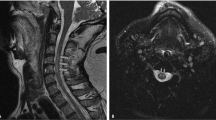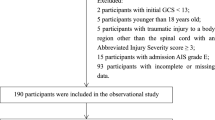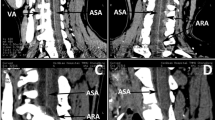Abstract
Study design:
Prospective study.
Objective:
To ascertain the prevalence of posterior circulation stroke in traumatic chronic spinal cord injured (SCI) patients and associated traumatic vertebral artery injuries (VAI).
Methods:
All adult patients with cervical SCI and American Spinal Injury Association Impairment Scale (AIS) grade A or B referred for follow-up magnetic resonance imaging of their spinal cord were invited to take part in the study between January 2010 and December 2012 at the National Spinal Injury Centre. Two additional sequences were added to the existing imaging protocol to evaluate the brain and vertebral arteries.
Results:
Ninety-eight patients were recruited. All imaging were analysed independently by three consultant radiologists. Posterior circulation infarcts were noted in seven (7%) patients. Significant VAI was noted in 13 patients (13%) with 10 occlusions and 3 with high-grade stenosis. However, only one patient had co-existent posterior circulation infarct and significant VAI.
Conclusion:
There is an increased prevalence of posterior circulation infarction in SCI patients. The relationship with associated traumatic VAI requires further investigation.
Similar content being viewed by others
Log in or create a free account to read this content
Gain free access to this article, as well as selected content from this journal and more on nature.com
or
References
Biffl WL, Moore EE, Elliott JP, Ray C, Offner PJ, Franciose RJ et al. The devastating potential of blunt vertebral arterial injuries. Ann Surg 2000; 231: 672–681.
Mueller CA, Peters I, Podlogar M, Kovacs A, Urbach H, Schaller K et al. Vertebral artery injuries following cervical spine trauma: a prospective observational study. Eur Spine J 2011; 20: 2202–2209.
Torina PJ, Flanders AE, Carrino JA, Burns AS, Friedman DP, Harrop JS et al. Incidence of vertebral artery thrombosis in cervical spine trauma: correlation with severity of spinal cord injury. AJNR Am J Neuroradiol, [Comparative StudyResearch Support, US Gov't, Non-P.H.S.] 2005; 26: 2645–2651.
Taneichi H, Suda K, Kajino T, Kaneda K . Traumatically induced vertebral artery occlusion associated with cervical spine injuries: prospective study using magnetic resonance angiography. Spine 2005; 30: 1955–1962.
Miller PR, Fabian TC, Bee TK, Timmons S, Chamsuddin A, Finkle R et al. Blunt cerebrovascular injuries: diagnosis and treatment. J Trauma 2001; 51: 279–285 discussion 85-6.
Zavala-Alarcon E, Emmans L, Little R, Bant A . Percutaneous intervention for posterior fossa ischemia. A single center experience and review of the literature. Intl J Cardiol, [Review] 2008; 127: 70–77.
Friedman D, Flanders A, Thomas C, Millar W . Vertebral artery injury after acute cervical spine trauma: rate of occurrence as detected by MR angiography and assessment of clinical consequences. AJR Am J Roentgenol 1995; 164: 443–447 discussion 8-9.
Quint DJ, Spickler EM . Magnetic resonance demonstration of vertebral artery dissection. Report of two cases. J Neurosurg 1990; 72: 964–967.
Weller SJ, Rossitch E, Malek AM . Detection of vertebral artery injury after cervical spine trauma using magnetic resonance angiography. J Trauma, [Case ReportsReview]. 1999; 46: 660–666.
Eberhardt O, Naegele T, Raygrotzki S, Weller M, Ernemann U . Stenting of vertebrobasilar arteries in symptomatic atherosclerotic disease and acute occlusion: case series and review of the literature. J Vasc Surg, [Case ReportsReview] 2006; 43: 1145–1154.
Vernooij MW, Ikram MA, Tanghe HL, Vincent AJ, Hofman A, Krestin GP et al. Incidental findings on brain MRI in the general population. N Engl J Med, [Research Support, Non-U.S. Gov't] 2007; 357: 1821–1828.
Boon A, Lodder J, Heuts-van Raak L, Kessels F . Silent brain infarcts in 755 consecutive patients with a first-ever supratentorial ischemic stroke. Relationship with index-stroke subtype, vascular risk factors, and mortality. Stroke 1994; 25: 2384–2390.
Compter A, van der Worp HB, Algra A, Kappelle LJ . Prevalence and prognosis of asymptomatic vertebral artery origin stenosis in patients with clinically manifest arterial disease. Stroke, [Research Support, Non-US Govt] 2011; 42: 2795–2800.
McCormick MT, Robinson HK, Bone I, McLean AN, Allan DB . Blunt cervical spine trauma as a cause of spinal cord injury and delayed cortical blindness. Spinal Cord, [Case Reports] 2007; 45: 687–689.
Miller PR, Fabian TC, Croce MA, Cagiannos C, Williams JS, Vang M et al. Prospective screening for blunt cerebrovascular injuries: analysis of diagnostic modalities and outcomes. Ann Surg, [Comparative Study] 2002; 236: 386–393.
Wei CW, Montanera W, Selchen D, Lian J, Stevens C, de Tilly LN . Blunt cerebrovascular injuries: diagnosis and management outcomes. Can J Neurol Sci 2010; 37: 574–579.
Biffl WL, Ray CE, Moore EE, Franciose RJ, Aly S, Heyrosa MG et al. Treatment-related outcomes from blunt cerebrovascular injuries: importance of routine follow-up arteriography. Ann Surg 2002; 235: 699–706.
Park JH, Kim JM, Roh JK . Hypoplastic vertebral artery: frequency and associations with ischaemic stroke territory. J Neurol Neurosurg Psychiatry 2007; 78: 954–958.
Biffl WL, Moore EE, Offner PJ, Brega KE, Franciose RJ, Burch JM . Blunt carotid arterial injuries: implications of a new grading scale. J Trauma 1999; 47: 845–853.
Harrigan MR, Weinberg JA, Peaks YS, Taylor SM, Cava LP, Richman J et al. Management of blunt extracranial traumatic cerebrovascular injury: a multidisciplinary survey of current practice. World J Emerg Surg 2011; 6: 11.
Katzman GL, Dagher AP, Patronas NJ . Incidental findings on brain magnetic resonance imaging from 1000 asymptomatic volunteers. JAMA 1999; 282: 36–39.
Acknowledgements
We wish to thank Ms. Deborah King for the valuable help and advice on study design and excellent technical assistance. This work was supported by the UK Spinal Cord Injury Network (grant no. SCI18).
Author information
Authors and Affiliations
Corresponding author
Ethics declarations
Competing interests
The authors declare no conflict of interest.
Rights and permissions
About this article
Cite this article
de Heredia, L., Belci, M., Briley, D. et al. Posterior circulation infarction in patients with traumatic cervical spinal cord injury and its relationship to vertebral artery injury. Spinal Cord 53, 125–129 (2015). https://doi.org/10.1038/sc.2014.145
Received:
Revised:
Accepted:
Published:
Issue date:
DOI: https://doi.org/10.1038/sc.2014.145



